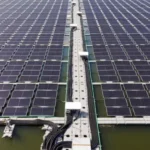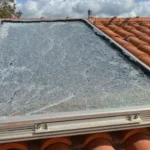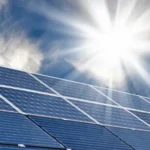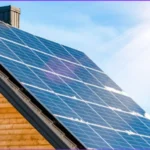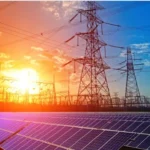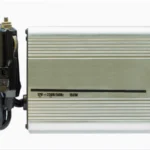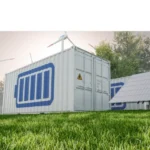Ever wondered what happens if a golf-ball-sized hailstone slams into your rooftop solar panels? For many homeowners, the thought of investing thousands into solar only to have it shattered by a storm is nerve-wracking. The truth is, modern panels are surprisingly durable, but they are not invincible.
In my years working with solar installations across Texas, Colorado, and Kansas (some of the hail capitals of the U.S.), I have seen everything from hairline glass cracks that went unnoticed for months to full-on panel destruction after freak weather events. In this article, we will break down how solar panel hail damage happens, how to protect your investment, and what to do if it ever occurs without sugarcoating the realities.
Also click here : Energy storage solution.

What Is Solar Panel Hail Damage and How Common Is It?
Solar panel hail damage refers to physical harm to the glass surface or internal components of a photovoltaic panel caused by hailstones. The most common signs include:
- Spiderweb-like cracks in the tempered glass
- Visible dents or pitting (on frame or cells)
- Drops in energy production without visible damage (microcracks)
The good news? According to the National Renewable Energy Laboratory (NREL), only 0.05% of PV panels installed in the U.S. suffer hail damage each year. That is largely because reputable panels undergo IEC 61215 impact testing, which simulates hail impacts at up to 51 mph with 1-inch ice balls.
The bad news? Severe weather events are becoming more frequent, and in states like Texas, 2-inch hailstones are not uncommon, exceeding standard test parameters.
Hail Resistance: How Tough Are Solar Panels, Really?
Modern solar panels are built with:
- Tempered Glass: Up to 4mm thick, designed to absorb impact and prevent shattering
- Aluminum Frames: Provide rigidity and help distribute force
- Encapsulants: Protective layers that shield cells from moisture and vibration
Most Tier 1 panels can withstand 1-inch hail at 50 mph. Premium models (like some LG and Q Cells lines) are rated for up to 2-inch hailstones.
Installer Insight:
“I have been installing in Colorado for 12 years,” says Maria Gutierrez, a NABCEP-certified solar installer. “Out of over 400 systems, only three had panel replacements due to hail, and two of those were freak baseball-sized storms.
Also visit here : product.
How Hail Damage Impacts Solar Output
Even if the glass does not shatter, microcracks in the cells can form from hail strikes. These hairline fractures:
- Reduce the panel’s ability to conduct electricity efficiently
- Can cause hot spots, which shorten panel lifespan
- May cause gradual output decline, sometimes up to 15% in the first year after damage
If your system suddenly drops production after a hailstorm, it is time to inspect.
Signs Your Panels May Have Hail Damage
Here is what to look for after a storm:
- Visible spider cracks in the glass surface
- Unexpected dips in your solar monitoring app
- Water ingress around the frame or junction box
- Loose mounting hardware caused by storm vibration

What to Do Immediately After Suspected Solar Panel Hail Damage
- Step 1: Turn off your system if there is visible, severe damage to avoid electrical hazards
- Step 2: Document everything with photos before touching the panels
- Step 3: Check your production logs from before and after the storm
- Step 4: Contact your installer for a professional inspection
- Step 5: File an insurance claim if necessary (more on this next)
Insurance and Warranty Coverage for Hail Damage
Homeowner’s Insurance:
Most standard policies cover solar panel hail damage because panels are considered a permanent home fixture. Keep in mind:
- You will likely have to pay a deductible
- Your provider may require proof of damage from a licensed installer
Manufacturer Warranties:
- Most panel warranties (25–30 years) do not cover weather-related damage unless explicitly stated
- Performance warranties will not apply if the cause of underproduction is physical damage from weather
Preventing Solar Panel Hail Damage
While you cannot control the weather, you can reduce risk:
1. Choose High-Hail-Rated Panels
- Ask your installer for panels tested beyond IEC standards
- Panels rated for 2-inch hail at higher speeds are ideal in hail-prone areas
2. Install at a Steeper Tilt
- Panels mounted at 40° or more are less likely to take direct perpendicular hits
3. Temporary Protective Covers
- Some homeowners use removable hail guards made of mesh or polycarbonate sheets during peak storm seasons
4. Routine Maintenance
- Regular inspections help catch microcracks before they worsen
Real-World Example: When a Storm Tests Your System
One of my clients in Amarillo, TX had a 10kW rooftop array installed in 2018. In April 2023, a freak storm dropped 2.5-inch hailstones for nearly 15 minutes. Out of 28 panels, 6 showed visible cracks and 2 had stopped producing entirely.
Because we had thorough monitoring data and photos, the homeowner’s insurance covered 100% of replacement costs (minus deductible). Within three weeks, the damaged panels were swapped out, and the system was back to full output.

How to Check for Hidden Hail Damage
Not all hail damage is visible to the naked eye. Here is a quick DIY plus pro approach:
- Check your monitoring portal for unusual dips in production
- Inspect with binoculars from a safe distance
- Schedule an infrared (IR) scan with your installer to detect microcracks or hot spots
Hail Damage vs. Other Solar Risks
While hail grabs headlines, other threats can be equally costly:
- Soiling Loss: Dirt, pollen, or bird droppings can reduce output by up to 20% and are easily fixed with cleaning
- Inverter Failure: The inverter is often the first component to fail; annual checks can prevent downtime
- Battery Degradation: Overcharging and high heat can reduce battery life, especially in off-grid setups
Pro Maintenance Tips for Long-Term Solar Performance
- Clean Panels Every 3–6 Months
- A soft brush and deionized water work well
- Avoid high-pressure washing, which can damage seals
- A soft brush and deionized water work well
- Monitor Output Weekly
- Use your inverter app to spot trends
- Use your inverter app to spot trends
- Inspect After Every Major Storm
- Even without visible hail damage, schedule a professional check
- Even without visible hail damage, schedule a professional check
- Service Batteries Annually
- Especially critical for off-grid and hybrid systems
Solar EV Charging and Hail Protection
If you have an EV charger powered by rooftop solar, hail damage to panels can directly affect your charging capability. Some homeowners choose to install a small ground-mounted array with protective awnings for critical loads like EV charging and refrigeration.
Final Thoughts on Solar Panel Hail Damage
Solar panels are built tough, and most will shrug off average hailstorms without a problem. But in hail-prone regions, proactive planning, selecting the right panels, installing at the right tilt, and knowing your insurance coverage can save you thousands down the line.
If your panels have not been inspected since your last major storm, you could be running at reduced capacity without knowing it. Book a professional hail damage inspection today and ensure your system is producing at its full potential.


